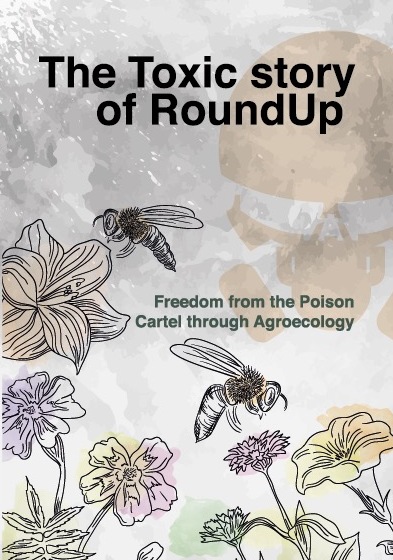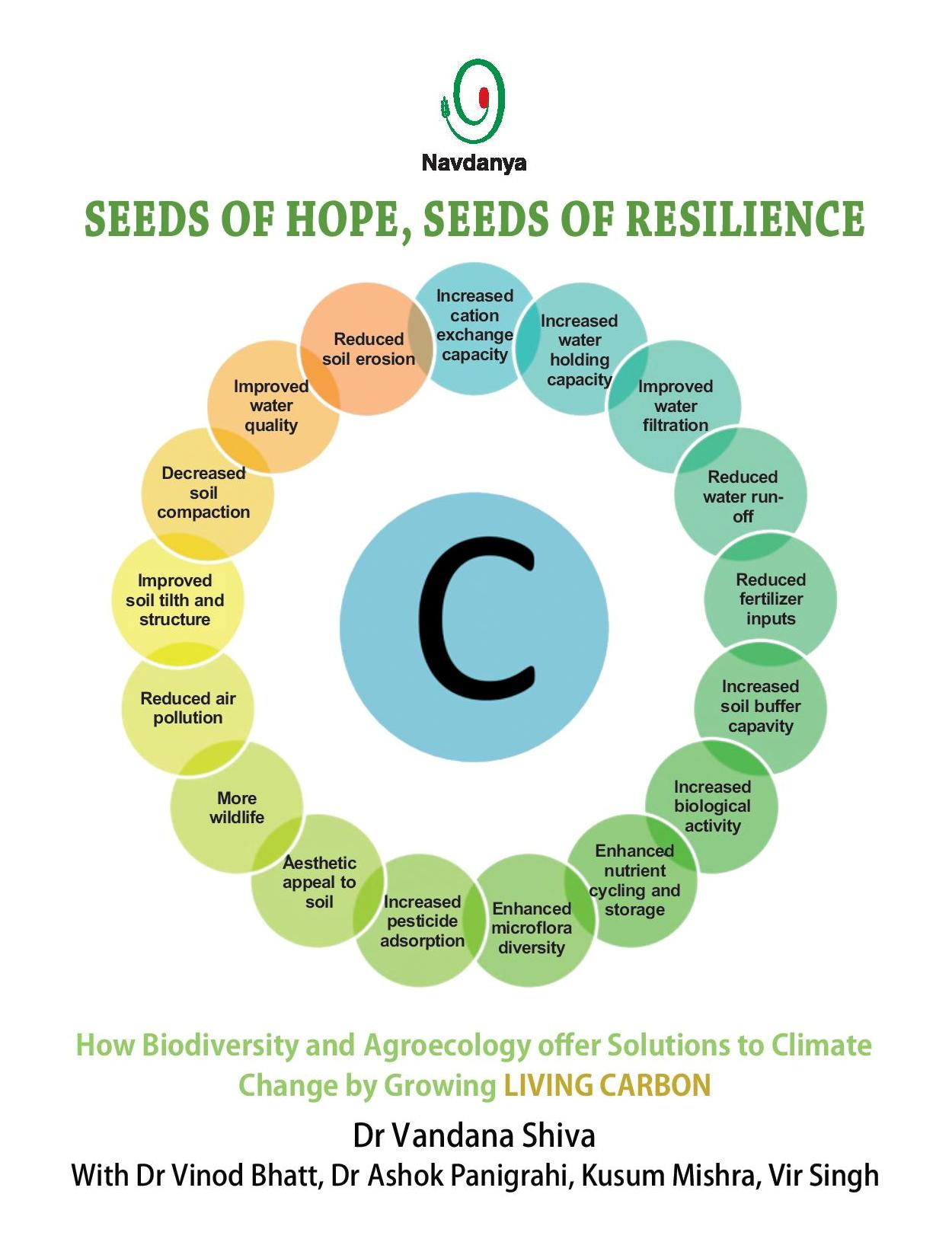
By Ruchi Shroff – Lifegate, 18 September 2017 | Source
A world free from poisonous chemicals is possible. And it’s in our hands. The op-ed by the Director of Navdanya International, the organisation that protects nature, the Earth’s biodiversity and people’s rights to seeds and food.
Corporations are putting our lives and our environment at risk through a growing and improper influence over institutions, whose responsibility should be, instead, protecting people and the planet. The visible consequences have made it imperative to expose their devious tactics and their steadfast and corrupt lobbying, recently revealed in the Poison Papers (a compilation of over 20,000 documents obtained from federal agencies and chemical manufacturers about the toxicity of many chemical products, editor’s note). Up until this stark revelation, corporations have almost totally been absent from everyday news. What is increasingly clear to all is the impact of their “busyness” on our lives – an environment that is increasingly polluted and toxic, bad quality and unhealthy food, and an increase in disease, all of which too often aren’t directly linked to these companies and the consequences of their policies in the public debate.
The Poison Cartel
Evidence of the toxic consequences of the policies of these mega corporations, which we call the Poison Cartel, is however growing by the day – small farmers are losing their livelihoods, rural populations are being driven from their land to make way for industrial agriculture, biodiversity is fast disappearing to make way for monocultures, and consumers increasingly have no option other than to buy toxic food grown in increasingly contaminated, chemical infested soils.
Navdanya International‘s latest report, The Toxic Story of RoundUp, unveils this corrosive business and indicates, at the same time, the alternatives to the poison model of agriculture which can’t be considered sustainable or ethical from any point of view.
A poison-free world
Is a poison-free world possible? We believe it is, which is why we must denounce the alarming and dangerous activities of the Poison Cartel. The “Big 6” pesticide and GMO corporations that own the world’s seeds, pesticides and biotechnology industries are now enlarging their empire with mega buyouts. Syngenta is merging with ChemChina (43 billion dollar deal); Dow Chemical, which bought up Union Carbide – responsible for the Bhopal disaster killing over 20,000 people, is merging with Dupont (130 billion dollar deal); while Bayer is now merging with Monsanto (57 billion dollar deal). Should all these mergers be approved by EU and US regulators, just three companies will be left in control of 60 per cent of the world’s seeds and 70 per cent of its chemicals and pesticides.
Over the last decades these companies – which produced lethal poisons during the two world wars – turned to the agricultural market, where they saw enormous potential to keep multiplying their profits. They have enlarged their empires and established monopolies through free trade neoliberal policies and deregulation of commerce, broadening their control over our seeds, food, freedom and democracies. In the name of science these war-based corporations attack independent science and independent scientists to maintain and expand their empires. Corporate propaganda is their so-called science, and the science of biosafety by independent governments and scientists is branded “anti-science”.
Our last studies expose in detail their strategies to generate profits at the expense of the common interest. But what does this actually mean? These corporations liberally spread agrochemical poisons wherever they can, wiping out millions of species, destroying our ecosystems, poisoning the entire web of life. Due to its widespread use, glyphosate is considered the most widely used agricultural chemical in history. Since its introduction, 1.8 million tonnes have been applied to American fields, and 9.4 million tonnes have been applied globally. Some 56 per cent of the total global usage of glyphosate is related to RoundUp Ready (RR) crops, and it has tripled on cotton farms, doubled on soybeans and increased 39 per cent on corn. This is a trend that has to be reversed as we’re also talking about a failed technology. US farmer fields have been witnessing the uncontrolled spread of “superweeds” like amaranth, especially in the south-eastern states, where approximately 92 per cent of RR cotton and soybeans are infested. As a consequence, farmers have started to increase the use of pesticides.
The impact on the environment
We turn now to the propaganda of the Poison Cartel. Is it true these products don’t have any impact on the environment? This has no place in reality. A pilot study on soil contamination by the Joint Research Centre of the European Commission and Wageningen University in which soil samples were collected in various parts of Europe have found pesticide traces in over 66 per cent of the samples analysed, while only 34 per cent of the samples were clean. The most commonly recognised substances are glyphosate (46 per cent), DDT (25 per cent) and fungicide products (24 per cent). The study points out that glyphosate and AMPA (Aminomethylphosphonic acid) can concentrate on very small soil particles that are easily eroded and transported by wind and water. This shows that there is actual risk of contamination even at very long distances. A recent US Geological Survey study sampled waterways in 38 states and found glyphosate and AMPA in the majority of rivers, streams, ditches and wastewater treatment plant outfalls tested. Glyphosate was also found in about 70 per cent of rainfall samples.
The myths about pesticides
One of the myths is that “pesticides are rigorously tested”. Besides the fact that only a few hundred of the 80,000 chemicals used in US are tested for safety (USPCP), regulatory agencies only test the active substance of individual pesticides based on the indication provided by the manufacturers, avoiding to investigate either the toxicological risk of the product as a whole (complete with co-adjuvants and co-formulants) or in combination with the overall mix of pesticides available on the market and often simultaneously used in fields and gardens.
The agrochemical industry will respond to the first objection with the assertion that pesticides are instead necessary to feed the world, which is both inaccurate and misleading because theoretically there is enough food to adequately provide for global needs, but those who most need it are prevented from receiving because of inequitable production and distribution systems. While causing 75 per cent of the planetary destruction, it only provides 30 per cent of the food, which is nutritionally empty and loaded with toxics. The toxic products of the Poison Cartel such as RoundUp (glyphosate) and Basta (glufosinate) or GMO seeds have led to the destruction of soils, desertification, extermination of bees, rise in health epidemics such as cancer and birth defects, amongst others.
Facts and figures about pesticides
So now let’s get back to reality as Hans Herren of Biovision Foundation recently suggested: 60 per cent of what you have in your plate needs bees. Animals are also affected and so are humans. As outlined in the latest report by the United Nations Special Rapporteur on the Right to Food, Hilal Elver, published in 2017, it is estimated that pesticides are responsible for the deaths of 200,000 people each year, of which 99 per cent from countries where environmental, health and work safety rules aren’t very restrictive or are scarcely applied. In a study promoted by the European Union on the impact of organic food and agriculture on human health research was undertaken on the overall impact of pesticides on human health. The report states: “100 pesticides are known to cause adverse neurological effects in adults, and all of these substances must therefore be suspected of being capable of damaging developing brains as well”. In our report we analyse numerous studies and cases, from Argentina to Costa Rica and Sri Lanka (where the government banned glyphosate in 2014).
Solutions are in our hands
What are the possible solutions? These are coming from the bottom rung. All over the world small farmers and gardeners are already implementing biodiverse ecological agriculture, while rejuvenating the soil and saving and breeding their seeds. They are providing healthy and nutritious food to their communities and bringing back food in the hands of farmers and consumers, making big agribusiness irrelevant and useless, along with their poisons and toxic food. In the course of 2016 more than 110 people’s assemblies were self-organised by local communities in 28 countries throughout the world establishing a worldwide network with the aim of creating a healthy future of food and of the planet. The global mobilisation culminated with the people’s assembly and the Monsanto Tribunal continued through 2017. Farming without poisons is in our hands. And as Navdanya’s work over the last three decades has shown we can grow enough nutrition for two times the current population, we can increase farmers’ incomes tenfold by giving up buying toxic chemicals, we can address malnutrition and chronic diseases, and we can create climate resilience.
Also read:

The Toxic Story of RoundUp: Freedom from the Poison Cartel through Agroecology


2 Comments, RSS